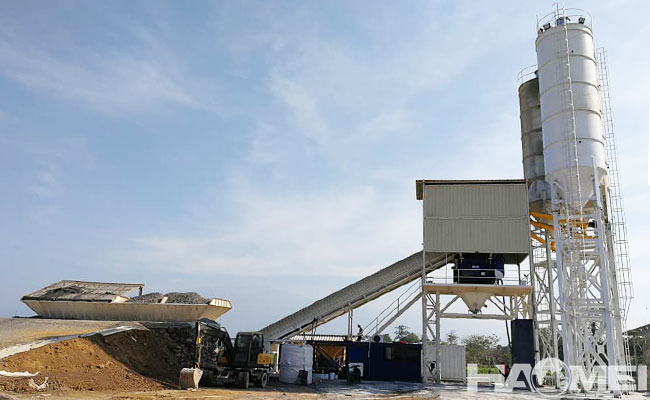New Concrete Batch Plant For Sale
Writer:Admin Time:25/06/19A new concrete batch plant has significant advantages in performance, technology, reliability and other aspects.
1. Performance and technological advancement
- Efficient production capacity guarantee
The new concrete batch plant adopts the latest design of mixing main machine (such as twin-shaft forced concrete mixer), and the mixing efficiency is more than 30% higher than the old model. It can produce 60-240 cubic meters of concrete per hour to meet the continuous construction needs of large-scale projects. For example, the theoretical capacity of the new HZS180 concrete batching plant is 180 cubic meters/hour, while the actual capacity of the used concrete batch plant that has been used for more than 5 years may drop to 120 cubic meters/hour.
- Accurate metering system
Equipped with high-precision sensors and intelligent control systems (such as PLC automation systems), the metering error of raw materials such as cement, sand, gravel, water, and admixtures can be controlled within ±1% (the error of the old station may reach ±3%), ensuring that the concrete strength grade (such as C30, C50) is stable and up to standard, reducing quality risks.
- Intelligent production management
Integrated IoT technology supports remote monitoring of production data (such as mix ratio, output, energy consumption), and real-time parameter adjustment through mobile APP or computer. Some new stations also have AI fault warning function, which can identify problems such as belt deviation and motor overheating in advance, reducing the risk of downtime.

2. Reliability and durability
- Core component upgrade
The main engine gearbox is made of high-strength alloy steel, with a service life of 8-10 years (the gearbox of the old station may need major repairs in 5 years); the mixing arm and liner are made of wear-resistant cast iron, and the replacement cycle is extended to 2-3 years (the old station needs to be replaced every year), reducing maintenance costs.
- Structural design optimization
The all-steel structural frame is adopted, with a wind load resistance of 12 levels (the used concrete batch plant may only be able to withstand 10-level wind), and the embedded parts of the equipment foundation have been mechanically calculated to avoid the main engine tilting problem caused by settlement, which is suitable for complex geological conditions.
3. Environmental protection and energy-saving advantages
- Low pollution emission
Equipped with high-efficiency pulse dust collector, dust emission concentration ≤30mg/m³ (used concrete batch plant may exceed 80mg/m³), in line with national environmental protection standards; the sealing system of the mixing host is upgraded to reduce cement dust; the wastewater recovery system can reuse the wastewater from the mixer after treatment, and the water resource utilization rate is over 90%.
- Energy-saving and consumption-reducing design
The use of variable frequency motor drive (such as feeding belt, screw conveyor) reduces energy consumption by 15%-20% compared with the used concrete batch plant. Taking the HZS120 concrete batching plant as an example, the new station consumes about 0.5 kWh of electricity per cubic meter of concrete, while the second hand concrete batching plant requires 0.6-0.7 kWh.
4. Convenience of operation and maintenance
- Humanized operation interface
The touch screen control screen supports English menus and graphical operations. New employees can get started in 1-2 days of training (old concrete batch plant may take 1 week), and the fault code is displayed in real time, which is convenient for quick troubleshooting.
- Optimization of maintenance space
Key components (such as oil pumps and sensors) adopt modular design and can be directly disassembled and replaced during maintenance, shortening maintenance time by 50%. For example, it only takes 2 hours to replace the mixing arm of a new concrete batch plant, while it may take 4-5 hours for an old concrete batch plant.
5. Adaptability and scalability
- Multi-scenario application support
Different functional modules can be configured according to needs:
Commercial concrete batch plant: increase the capacity of aggregate silos and automatic scheduling system to adapt to the batch production of commercial concrete;
Engineering concrete batch plant: integrated mobile chassis for easy site transfer;
Special concrete: add fiber feeding device to produce high-performance concrete (such as impermeable and crack-resistant concrete).
- Compatible with technical upgrades
Intelligent interfaces are reserved, which can be upgraded to unattended stations or connected to smart construction site management systems in the future, while second hand concrete batch plants are difficult to expand due to hardware limitations.
6. Comprehensive cost advantages
- High long-term cost performance
Although the purchase cost of a new concrete batch plant is 30%-50% higher than that of a second-hand concrete batch plant (such as a new HZS90 concrete batching plant of about 150,000 dollars, and a 5-year second-hand station of about 500,000 yuan), but:
- Maintenance costs can be reduced by 4,000-7,000 dollars per year (the average annual maintenance cost of the old concrete batch plant is about 10,000 dollars, and the new concrete batch plant is only 4,000 dollars);
- The benefits brought by increased production capacity (such as producing 20,000 cubic meters of concrete per year, calculated at 40 dollars/cubic meter, an annual increase of 800,000 dollars);
- The service life of the equipment can reach 10-15 years, and the remaining life of a second-hand concrete batch plant is usually only 5-8 years.
The new concrete batch plant is superior to the old equipment in terms of capacity, quality, cost and sustainability through technological innovation, performance upgrade and environmental optimization. It is especially suitable for large-scale projects with high requirements for construction efficiency and concrete quality, ready-mixed concrete enterprises or scenarios that require long-term stable production. When selecting a new plant, it is recommended to configure the equipment parameters in a targeted manner based on the production scale, concrete type (such as ordinary concrete, special concrete) and environmental requirements.
- Previous:Small Batching Plant For Sale...
- Next:What Is A Stationary Concrete Batch Mix Plant?...

